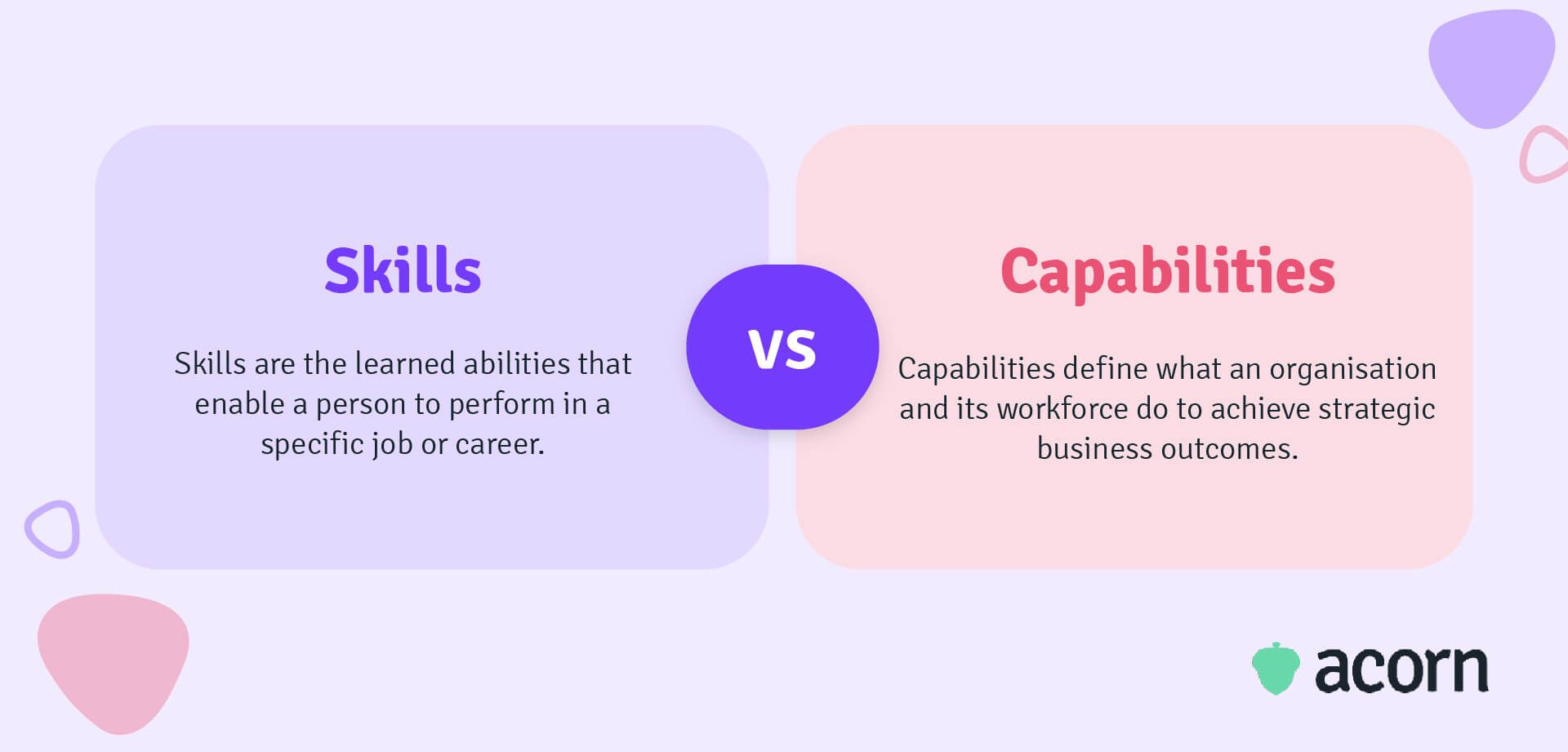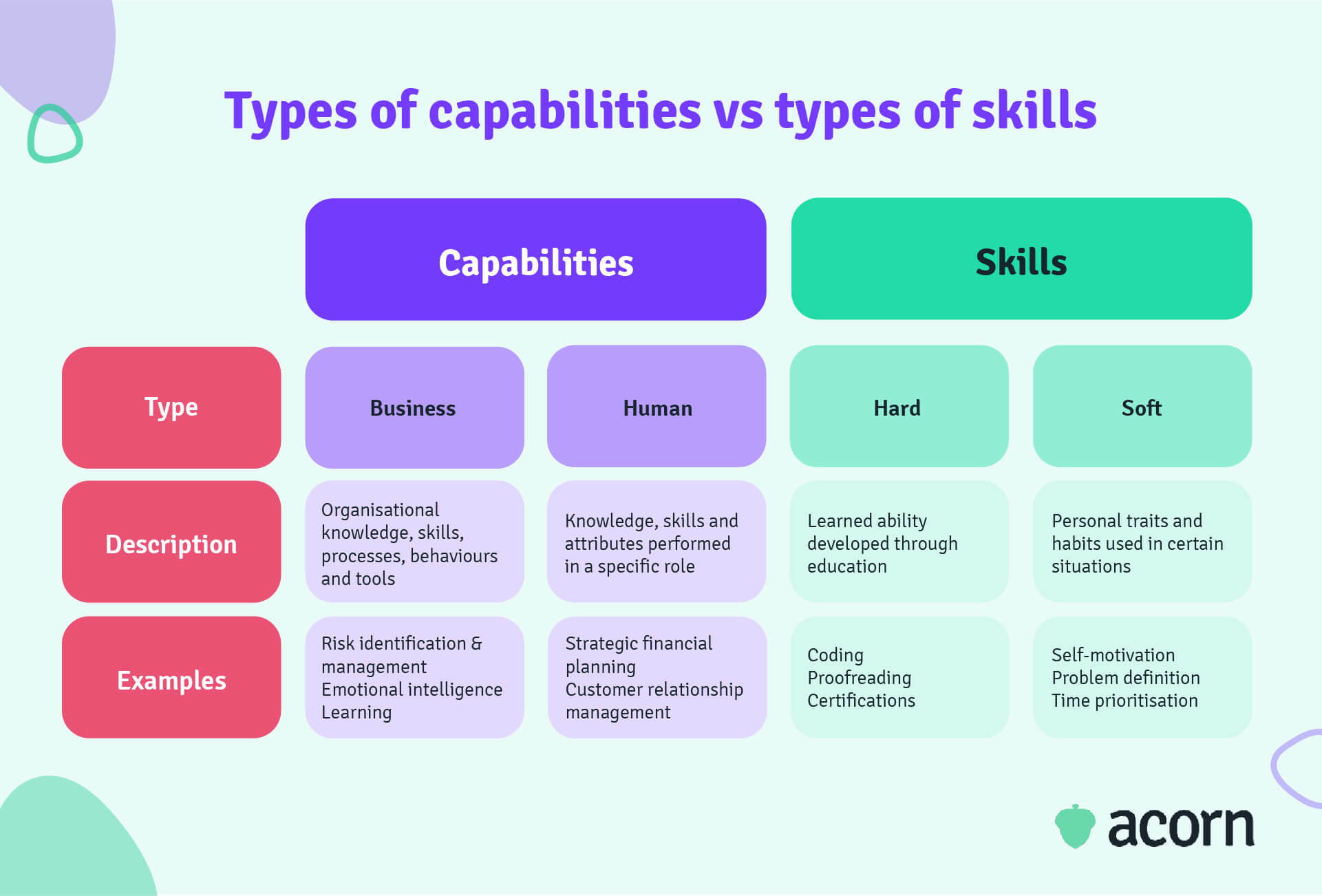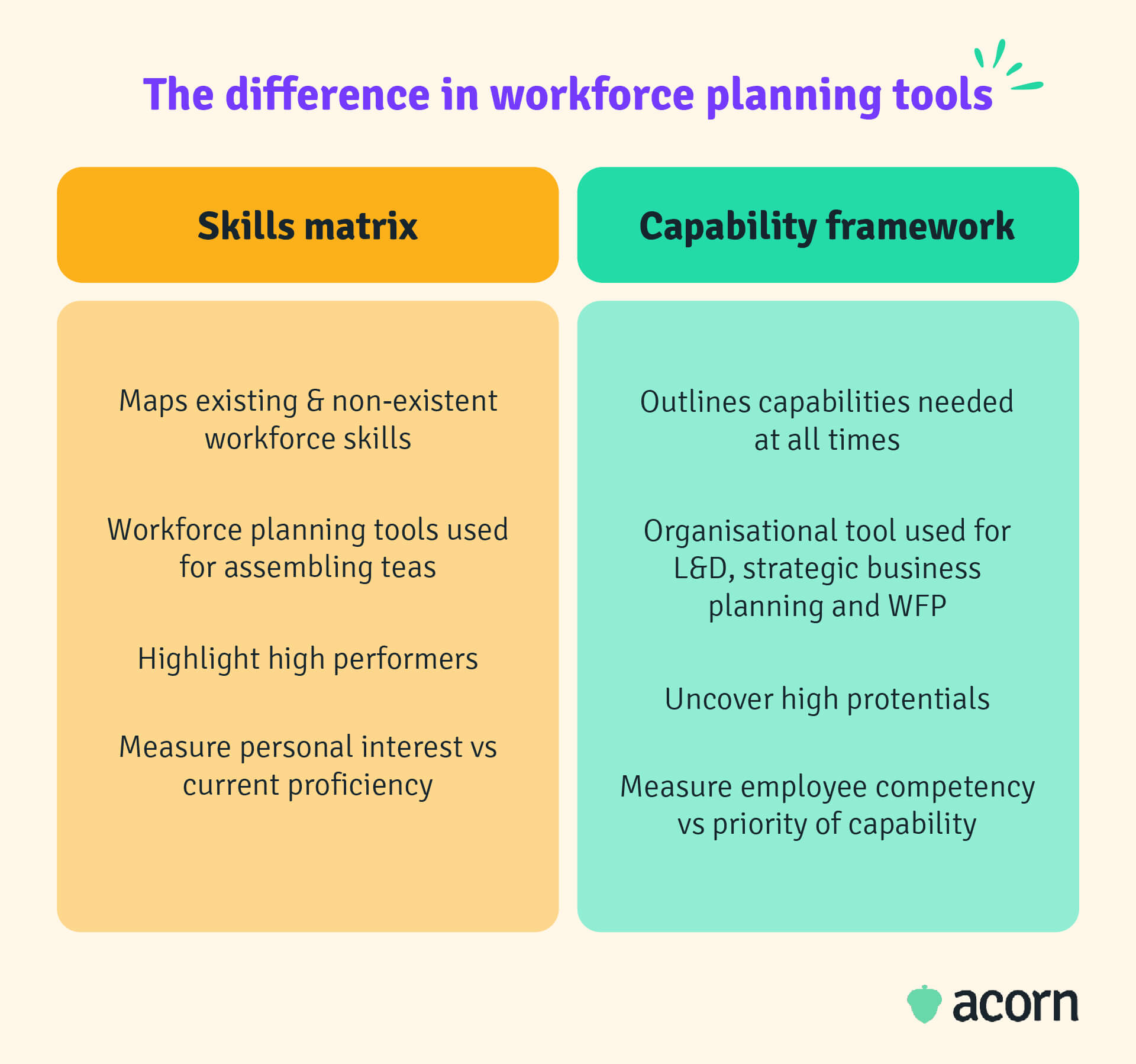Capabilities vs Skills: What Exactly Makes Them Different?
Reading Time:

Lead the pack with the latest in strategic L&D every month— straight to your inbox.
SubscribeSkills refer to the capacity to perform a task, whilst capabilities allow outcomes to be generated. But what really makes them different?
No doubt you’ve heard these two words thrown around in talent circles. But while some may use them interchangeably, there’s a difference between capabilities and skills.
We talk a lot about reskilling, upskilling and building employees’ skills. But the conversation should really be about organisational capabilities—because these can be built at the employee level to affect business change.
That’s the high level. The nuance that makes capabilities and skills different plus how to improve both is in this article.
What are capabilities?
Capabilities are a combination of knowledge, skills, tools, processes and behaviours that define what a company does to fulfil business strategy and satisfy clients or stakeholders. When compiled in a framework, capabilities are used to drive outcomes that contribute to an organisation’s performance, strategy and brand identity.
What are skills?
Skills are the talent, knowledge or expertise needed to perform a task or job. A skill is developed through experience or education. You can be technically skilled in order to do your job or possess soft skills that impact your interpersonal relationships.
The difference between capabilities and skills
There are two major differences we want to walk you through: Purpose and longevity.

Difference 1: Purpose
Consider something that you need to do in your job. Verbal communication, as an example. That is a single thing a person can do and learn to do in their job role.
But none of these skills can drive a business forward, because there is more to a job than just speaking to others. When you begin to group that with other like skills, such as listening and empathy, you have a capability (that might be called something like Effectively communicate).
A capability is a collection of related skills, behaviours and processes that drive a business forward. It is something both an employee and organisation needs; the former, in order to perform their job and drive value, and the latter to achieve company goals. Effective communication could mean how employees behave with clients in order to drive sales and revenue.
Difference 2: Longevity
Technical skills expire, fast. Within five years of gaining them, to be exact. Soft and leadership skills have more of a chance, but they still won’t last the lifetime of your company. The external pace of change means you can’t rest on your laurels when it comes to skills, especially since they are specific learned abilities done in any one job. Think of them as a short-term tactic.
Capabilities, on the other hand, are strategic, stable and unique to your organisation. They can be acquired externally (from, say, an institution framework) but you’ll have to refine them internally so they make sense for your strategy and culture. That’s why they form the framework for organisational success. Capabilities (and the skills they embody) are assigned to tasks, roles, teams and departments to affect a certain outcome.
If you think this all sounds strange, remember that capabilities aren’t the goalposts. They are the plays you make to score on business outcomes. Skills are the individual moves that work together in those plays.
Why do I need to know the difference?
We’re not trying to say that skills aren’t important or that you shouldn’t consider them in workforce planning. They are simply one part of the picture.

Developing organisational capability is a critical task for HR. At the most foundational level, you need to identify the skills and abilities required for a specific job. But if you rely too heavily on the former, you can zoom too far in on one person’s knowledge and neglect the bigger picture.
Here’s another way to look at it.
- Skills refer to the acquired capacity to do something, like effectively communicate with different team mates. It’s what a person can do.
- Capabilities are a combination of unique abilities that impact organisational outcomes. Change management is a capability. Consider it a measure of how things get done.
Putting the focus back on capabilities places emphasis on the strategic impacts of professional development and workforce planning. And when there’s tangible links between L&D and ROI, you can better plan and argue for investments, resourcing and budget requests.
That’s important when you consider the learning solutions you’re on the hook for. Many legacy learning management systems push a broken skills-based ideology of the more content, the better. But learners are tired of the uninspiring training that offers, and business leaders aren’t seeing performance improvements because of it.
At Acorn, we pioneered the creation of a performance learning management system (PLMS) for this exact reason. The PLMS curates content for learners based on the specific capability needs of their roles, so you can provide contextual learning opportunities at scale, directly attributing learning to organisational performance by way of an AI-powered system that collects tangible evidence of behavioural change (not just learning completions) by way of competency.
Why capabilities are important in the workplace
Business pressures are only going to increase. Aside from the expected pressure to create more and new value, there’s the unexpected downshifts to the pact of change to worry about.
And the thing about change is that you can’t use old methods for new challenges. Many employee training programs focus on developing skills and competency for a current role, with occasional desires on succession planning. But the problem is this is a reactive process. You risk losing underdeveloped talent and falling behind the mark without some forward thinking.
Capabilities define what you need in the future as much as right now. This helps you design training programs (and job descriptions, roles and teams) that:
- Assess and address knowledge and skill gaps
- Prioritise at risk or highly impactful capabilities
- Create a talent pipeline of continuous leaders
- Ultimately contribute to the future-readiness of your workforce.
A capability framework is also an important workforce tool, as it helps you capture and benchmark each individual employee’s capabilities and competencies.

The reason it outpaces other business planning tools is it gives your organisation the dexterity to make strategically impactful HR decisions.
There is often untapped potential that can lead to attrition and productivity lag. When you consider jobs as groups of capabilities, you begin to see people in terms of their abilities and potential rather than the vertical they currently exist in. And this gives you the understanding you need for successful:
- Talent mobility. Particularly helpful for unexpected job vacancies or when crisis teams need to be assembled.
- Succession planning. Soft skills are harder to develop but increasingly crucial to business success, not least because they speak to a leader’s future ability to, well, lead others.
- Recruitment. Whether internal or external, you’ll be able to better match a suitable candidate to a given job when judging by their capabilities.
How to improve capabilities and skills
It’s all about empowering your employees to create new skills and apply capabilities as they see fit in the workplace leads to real business impact.
Link training to business needs
Personalising training to career aspirations gives employees a reason to connect with it. You can boost that motivation and your ROI tenfold by tailoring career pathways to strategic objectives.
- Start with jobs most likely to be impacted by technological changes. This gives you a baseline of capabilities, transferable or otherwise, those employees possess. You can then map the gaps between where they are and the role they may transition into.
- Look at the development plans your high potentials are currently on. For example, are you choosing them based on job descriptions or competencies?
Embed learning in culture
Just as jobs are impacted by technological change, learning is disrupted by evolution. People are busier at work with more opportunities for distraction. Short-form learning in the moment of need is more necessary than ever.
If employees aren’t encouraged or able to access resources, you’re discouraging problem solving. That knocks onto innovation and agility at the organisational level because if your employees can’t innovate, your business hasn’t got a chance.
Enable human resources to think ahead
If you’re trying to achieve an entirely different future state, you’ll need different skills, knowledge and behaviours in future than you do now. Even if you want to maintain and build on success, you need to give HR and L&D teams the tools to plan for that future.
Workforce planning analytics use the data you already have at your disposal (people data held in HRIS and learning data from an eLearning solution) to map the gaps holding you back.
HR and L&D have also got oversight on other factors that can impact capability building, like:
- Overstaffing and understaffing.
- Organisational structure. (Are the right skills in the right place?)
- Costs, both in terms of labour and resources.
- Mobility of talent.
Key takeaways
Skills are the tactics that get you through the day (like time management and teamwork) while capabilities work towards long term success. Both are needed in an organisation—but in the capability vs skill fight, capabilities are the heavyweight.
Your capabilities are defined in the context of your environment and goals. This means you can better find and develop talent, place it where it needs to be, and talk about it in a language all employees can understand.
However, we still recommend you continue to develop both. This is because the competency of your workforce comes down to the personal competence of employees. Help them by:
- Linking their development opportunities to the bigger picture
- Encouraging a culture of continuous learning
- Enabling HR teams to strategically plan ahead.
Make sure to check out the next article, where we talk about how competencies differ from capabilities.